|
The Jungle Clay Lick
or
The Trials and Tribulations of
photographing parrots and macaws at a jungle clay lick in the "off season"
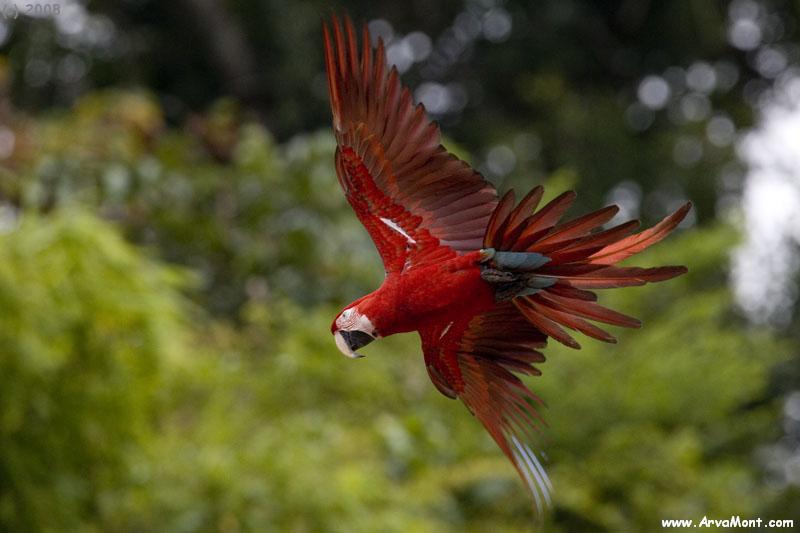
I
have always liked colorful parrots and macaws. When I read about "clay
licks" in the rainforest, I was immediately intrigued by them. (Clay licks
are areas where the birds can find important salts and minerals to neutralize
some of the toxins that build up as a result of their diet). From what I
had read, it sounded like hundreds of birds could frequent these licks and I
had formed an image in my mind of an "explosion of color" as they came and went
and bounced around on the clay lick. Unfortunately, May and June are, for some
reason, months in which the activity at the clay licks slows down or even
disappears, so our timing wasn't ideal (but not much we can do about that on our
trip). But I was still cautiously optimistic. 1 hour by plane from Cusco is Puerto Maldonado and 5 1/2 hrs by motorized canoe from Puerto Maldonado
is the Heath River Wildlife Center, in Bolivia. It has one of the most
accessible clay licks in the area, so off we went to Bolivia. Below is a
summary of what we encountered and what I learned about photographing at clay
licks frequented by macaws and parrots.
At
this particular clay lick, the parrots and the macaws appear in "shifts" - first
the parrots do their thing, then the macaws. They tend to visit early,
so there we were just before 6AM awaiting the first arrivals. The plan was
to have breakfast inside the floating hide while watching the birds, and wrap up
around 10 to return to the lodge. Little did I know how much time I would
end up spending in this particular blind hoping to get a couple of decent
pictures.
Start at the Top (or, can you say "backlighting?")
Something that I had not read was that when the parrots and macaws do arrive,
they work their way down to the clay lick: starting off at the tops of the
trees, and slowly moving down towards the lick as they get comfortable that it
is safe to do so, frequently getting spooked and flying off and then possibly
returning to start again. Unfortunately, on an overcast day (like all of
ours were), the lighting is particularly tough if you're shooting distant,
colorful subjects, way above you that are not directly illuminated and have a bright source of light
behind them - unless you like grey silhouettes. Exposing for the birds
meant completely washing out the background and the lack of direct lighting
resulted in very low contrast and dull colors that could not be completely brought back using Photoshop. Not the explosion of color I had
imagined, but this was the first step so we just had to wait through it.
On the off chance that nothing much were to happen, I took photos of the
birds way up high and off in the distance, but I wasn't holding my breath that
any would be particularly attractive - really, they would be more useful for identifying the
types of birds that we saw.
Parrots (and some
smaller macaws)
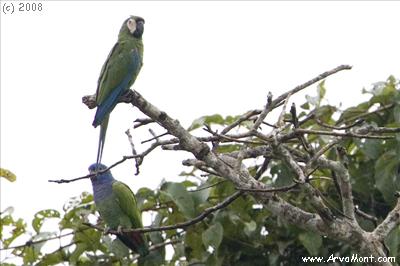
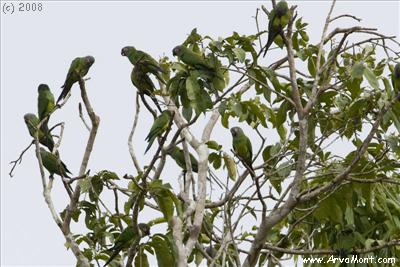
The big macaws
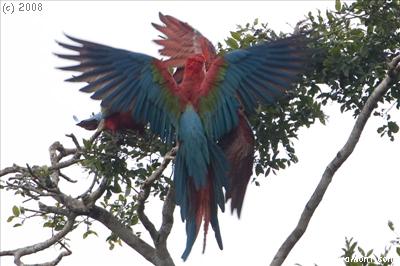
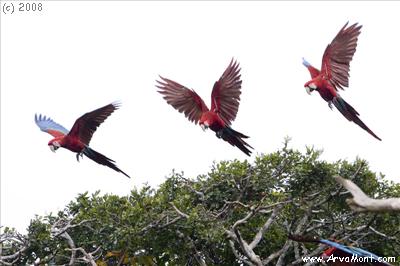
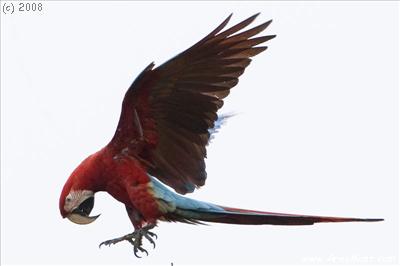
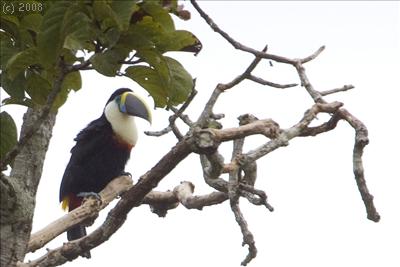
On our 2nd day, a toucan decided to make a cameo appearance :-)
On our first day
at the lick, we didn't get much activity - after 4 hours of hanging out in the
floating blind, we had seen maybe 1-2 dozen parrots and macaws way up high in
the trees, and only 1 parrot made it to the lick. I was bummed, but it
sounded like we had one more shot at it (pun intended) the next morning.
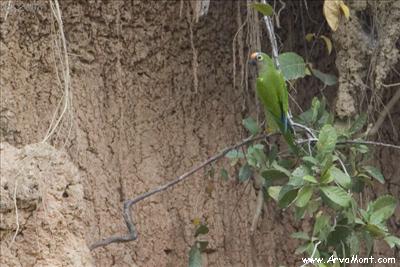
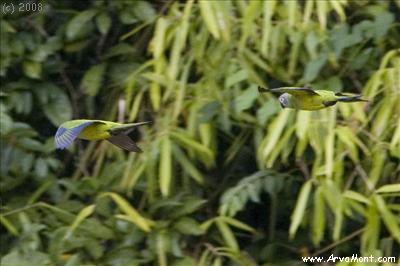
The sole parrot
that ventured down to the lick.
What the rest of the parrots did - flew off.
Day 2 - Taking a
liking to the lick
The next day, the
weather was overcast and drizzly when we were getting up at 5:30AM, so the guide
decided to postpone our visit by 30 minutes to give the weather a chance to
improve. At the hide around 6:30AM, we did the same thing as
yesterday...waited patiently while munching on pancakes and sipping coffee. Slowly but surely, the parrots arrived in small numbers and then
headed off without any clay. We're not sure if it was the weather, the
time of year, or this guy hanging around nearby:
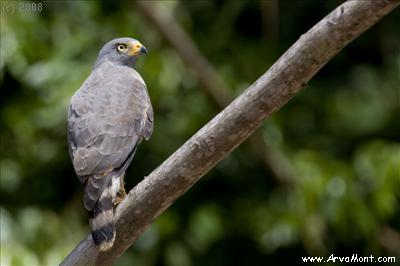 A Roadside Hawk (Yes, that is
its real name! It is a Buteo Magnirostris.) A Roadside Hawk (Yes, that is
its real name! It is a Buteo Magnirostris.)
Whether a result
of the hawk, or other reasons, the action was slow. Most folks were
getting bored and antsy and there was talk of heading out (by now, we'd been
there 3 1/2 hours after all). But the Macaws were gathering, and I was
hopeful. The general consensus was to head back to the lodge, but our
guide managed an option to let me stay and take a boat back at noon.
Thanks Julius! (Now, if only he could throw in some better lighting - I
should have noted that on his feedback form ;-) ).
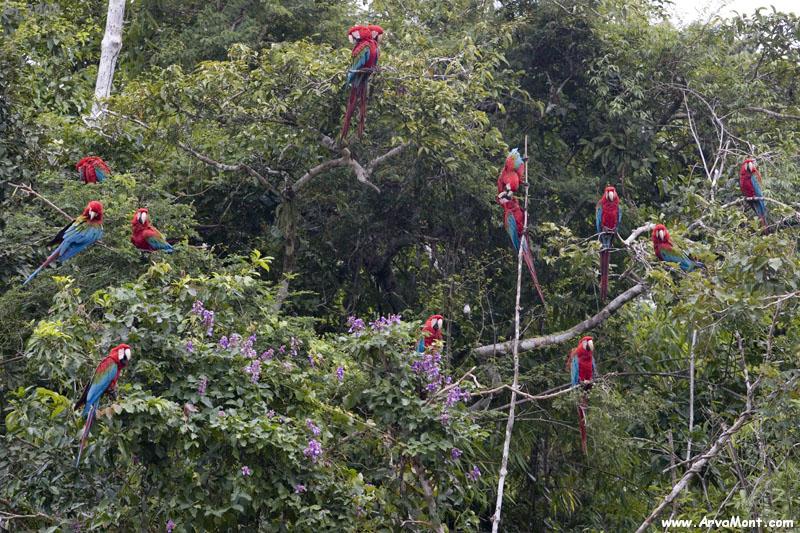
When the boat came
to take everyone back it created quite a scare with the macaws, but they all
returned a few minutes after the boat departed. Now I sat and hoped (and
watched the funny macaw antics).
Did somebody say
"party?"
As I was to
observe, not all the birds actually make it to the clay lick, and many didn't
even seem overly interested in it. Yet they hung out with all their bird
friends here. Julius explained that these birds are very social and that
the clay lick also gives them an opportunity to hang out together, renew bonds
and just plain have fun before they go off in their respective directions for
the day. Unfortunately, much of the party antics occurs at the tree tops
which meant more backlighting and muted colors. But the behaviors were
really fun to observe.
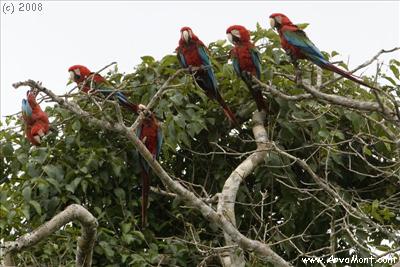
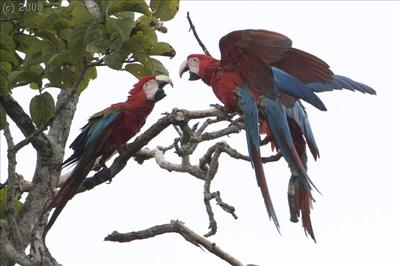
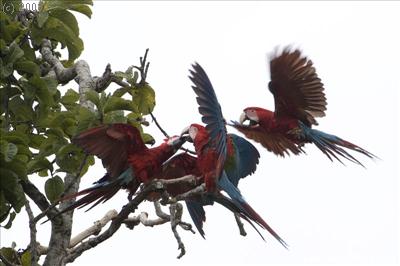
And slowly, but
surely, some started to move down towards the lick - all the while continuing
with their social antics.
|
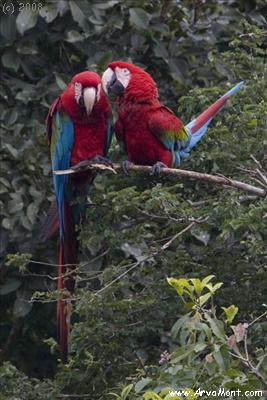
"Did you hear about....?" |
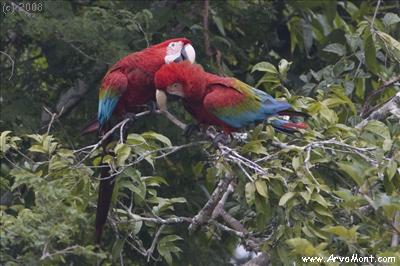
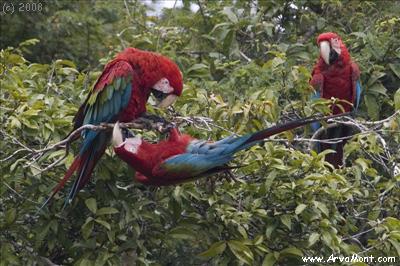 |
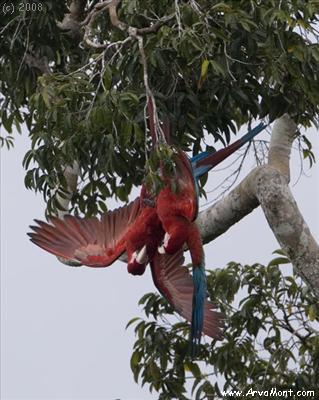 |
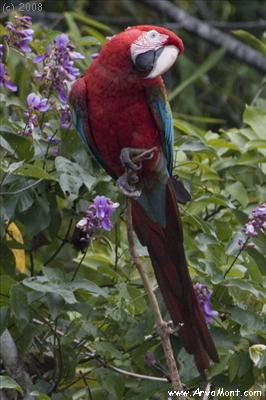
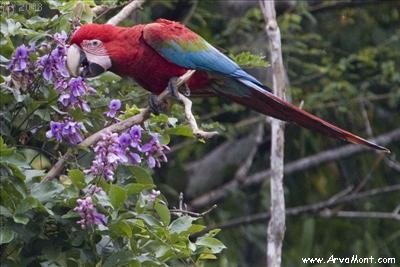
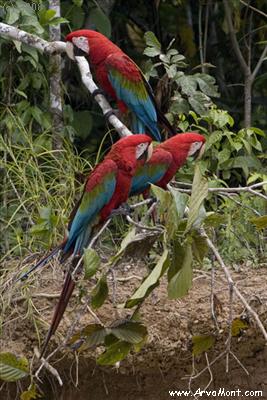
Finally, a few
macaws dropped down onto the lick and started getting some of their sought after
clay. In the "on season" hundreds of macaws will come to this area and
dozens of macaws will drop down to the lick. Today, we were fortunate that
there were about 70 macaws in the area and probably 5-10 on the lick.
Given the lick luck of the previous day, I wasn't complaining.
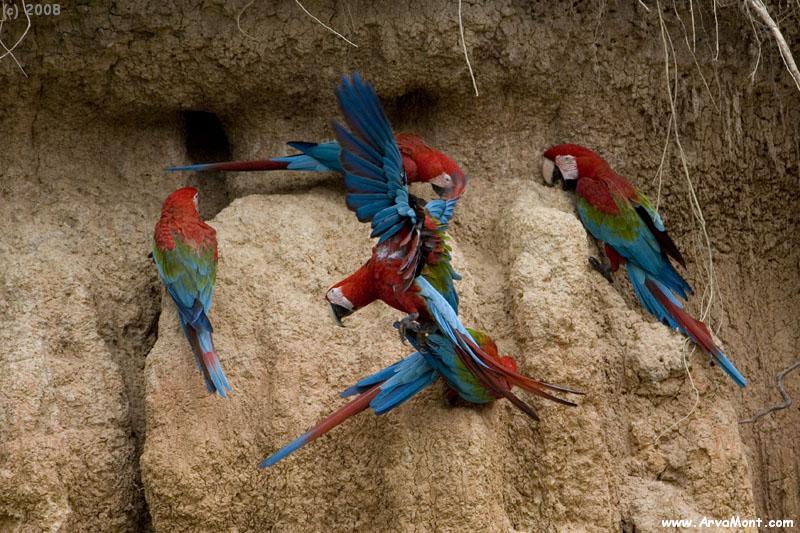
One thing I hadn't
expected: given the name "clay lick," I simply assumed that the birds come down
and lick it or eat little pieces of it. The guy below demonstrated a
different technique:
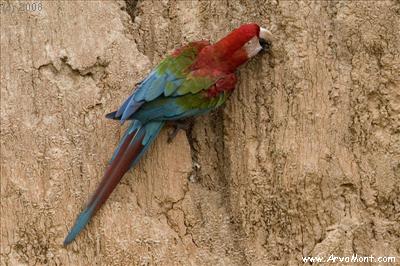
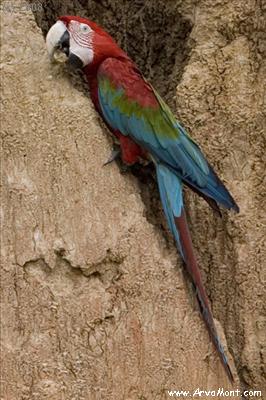
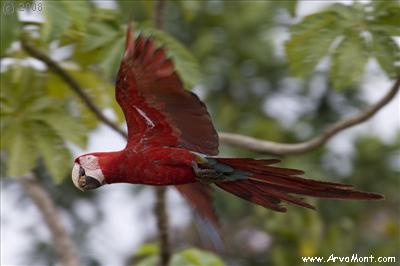
First, find a
desirable piece.
Then, rip it off.
And, finally, take it someplace quiet.
It was also cute
to see how flexible these guys were:
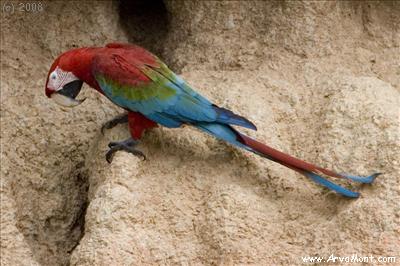
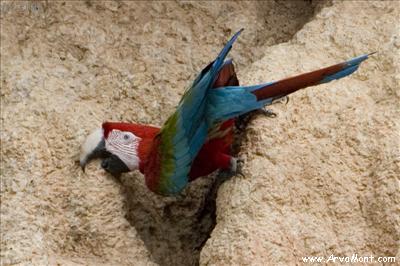
Hmmm .... I want
that chunk over.....
there!
So, while not
necessarily the spectacular "explosion of color" I wanted, it was nevertheless
interesting. And, as always, I had a blast trying to get a decent shot of
the birds doing their "thing." Someday, I may return, and this time I'll
try to time it a little better and spend a few extra days in hope of getting
some better light. Until then, I will remember the crazy antics and
beautiful colors of these funny, not so little, birds.
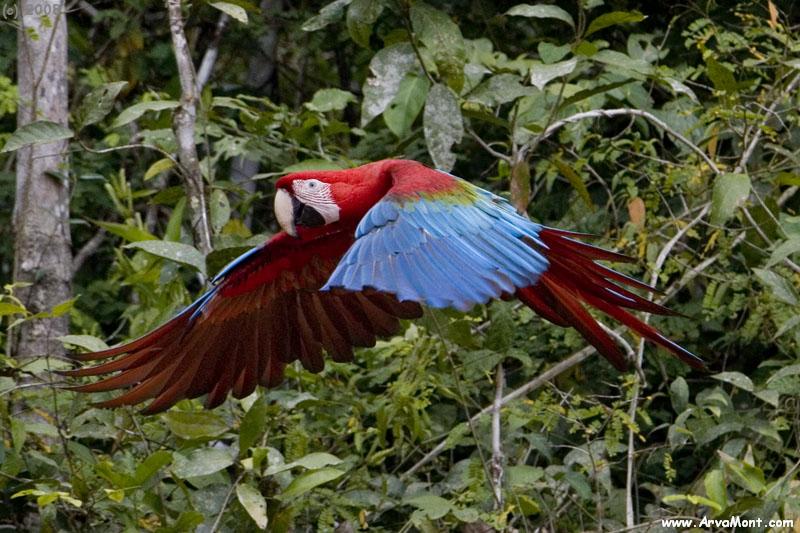
|  Around
the World With the ArvaMonts
Around
the World With the ArvaMonts


























